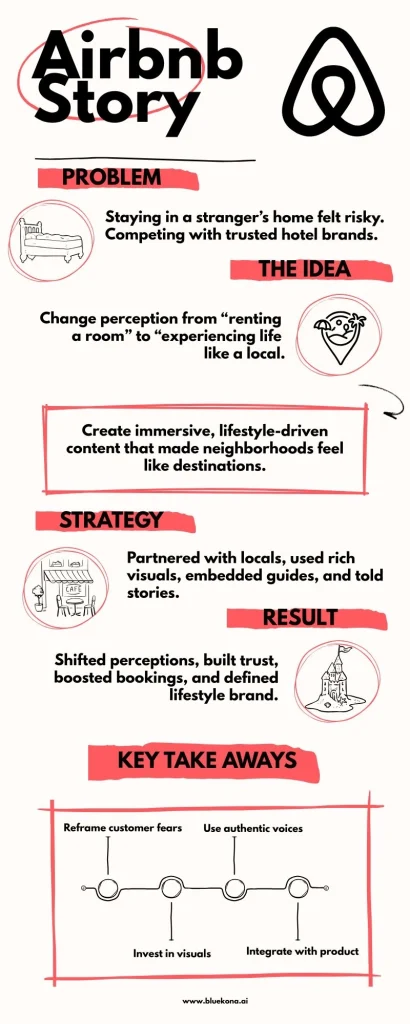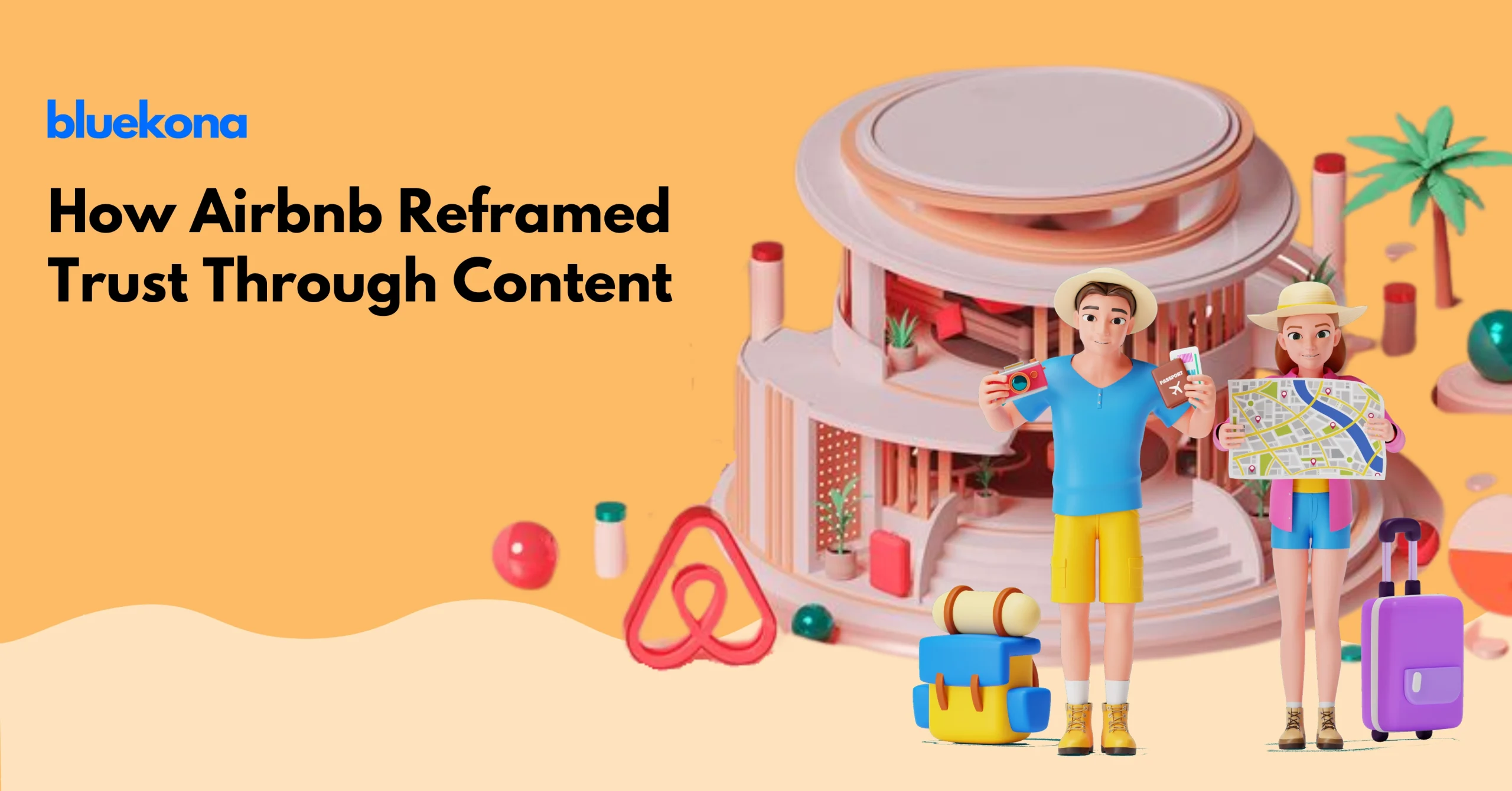When Airbnb launched, the idea of sleeping in a stranger’s home felt unsettling to many. Trust was a major hurdle — and one that traditional advertising couldn’t easily overcome.
Instead of pushing hard with ads, Airbnb took a different route: they used content to change how people felt. Their Neighborhood Guides didn’t talk about beds or bookings. They painted a picture of life in local neighborhoods — the kind of storytelling that made people feel like they belonged.
Let’s break down how Airbnb used content not just to promote, but to shift perception — and how marketers can learn from that approach
The Power of Content Marketing
Let’s be honest — traditional marketing can only take you so far, especially when trust is the barrier.
That’s where content marketing shines. It isn’t about pushing products, it’s about pulling people in with value, emotion, and story.
Content marketing works because it builds relationships before transactions. When done right, it educates, inspires, and slowly chips away at hesitation.
People don’t want to be sold to — they want to feel something, understand something, and connect with a brand’s bigger story.
For Airbnb, that story wasn’t “rent a room.” It was: belong anywhere. And to make that believable, they had to go beyond features and into feelings — which is exactly what great content marketing does.
In this case, the content didn’t just support the product. It transformed how people saw the product.

Airbnb’s Unique Challenge
Airbnb wasn’t just launching a product. They were introducing a completely new behavior — staying in a stranger’s home instead of a hotel. And as you can imagine, that raised a lot of eyebrows.
The idea sounded adventurous to some… and downright risky to others. Would the place be clean? Safe? Would the host be normal? These weren’t small concerns — they were major blockers to trust.
Airbnb knew it had to shift the narrative. This wasn’t just about lodging; it was about belonging, discovery, and local connection. But how do you reframe a concept that feels unfamiliar — maybe even uncomfortable — to so many people?
That’s where the Neighborhood Guides came in. Instead of focusing on the transaction (a bed, a price, a location), they focused on the experience — the smells, the sounds, the spirit of each place.
By making the unfamiliar feel familiar, Airbnb started breaking down that fear. And they did it not with ads — but with content.
Founding and Vision
Airbnb was founded in 2008 by Brian Chesky, Joe Gebbia, and Nathan Blecharczyk. Like many startups, it began with a problem: they couldn’t afford their San Francisco rent. So, they decided to rent out air mattresses in their apartment to conference attendees who couldn’t find hotel rooms — and called it “AirBed & Breakfast.”
From that quirky experiment came a powerful vision

That idea became Airbnb’s north star. The goal wasn’t just to offer cheaper stays, but to create a sense of belonging for travelers and hosts alike.
Early Market Positioning
In the beginning, Airbnb’s appeal was mostly about price and uniqueness. It wasn’t your standard hotel — and that was the point. You could stay in a treehouse, a loft, or a cozy backroom, often for less money.
But with that uniqueness came skepticism. Could travelers really trust a stranger’s home? Would the place be clean? Safe? As charming as the photos?
This trust gap — the hesitation many people felt — was Airbnb’s biggest obstacle in the early years. And it’s exactly the kind of challenge content marketing is built to solve.
The Neighborhood Guides weren’t just a creative side project — they were a strategic response to this trust problem. And in the next sections, we’ll explore how they helped Airbnb move from a fringe idea to a mainstream travel brand.

The Challenge
Airbnb wasn’t just trying to break into the travel market — it was trying to change the way people thought about travel entirely. And that meant facing some very real, very human obstacles head-on.
Fear of Staying with Strangers
At its core, Airbnb’s offering asked something big from users: trust. Trust that a stranger’s home would be safe. That it would be clean. That the photos were real. And that nothing unexpected — or uncomfortable — would happen.
For many people, the idea of staying in someone else’s home triggered a basic fear. We’re wired to be cautious in unfamiliar environments, and Airbnb was offering… well, unfamiliarity by design.
So even though the price might be right, and the photos might look amazing, that nagging voice inside many customers whispered “But what if it’s not what it seems?”
Airbnb needed to turn that voice down.
Competing with Established Hospitality
At the same time, Airbnb wasn’t just fighting fear — it was competing with giants. Traditional hotels had decades of brand trust, polished marketing, and consistent experiences. You knew what you were getting with a Hilton or Marriott.
Airbnb couldn’t win with glossy ads or deep pockets. What it needed was a different approach — one that made the experience feel richer, more meaningful, and more trustworthy than a cookie-cutter hotel room.
And that’s where content came in.
By shifting the focus from just “where you sleep” to “how you experience the city,” Airbnb had a chance to tell a better story — one that made staying in a stranger’s home feel less risky and more real.
That story came to life through the Neighborhood Guides, and they became one of Airbnb’s most effective content plays.
The Neighborhood Guides Strategy
To shift perception, Airbnb didn’t just need content — it needed content that made people feel something. That’s where the Neighborhood Guides came in.
How Airbnb’s Neighborhood Guides Were Created
When Airbnb set out to build the Neighborhood Guides, they didn’t treat it like a blog post or a quick content piece. They approached it like crafting a travel magazine — polished, personal, and visually rich.
Here’s how they pulled it off
1. Collaborating with Local Experts
Airbnb partnered with people who knew the neighborhoods best — locals, hosts, photographers, and even city insiders. They gathered real, lived-in knowledge about what makes each area special:
- The best coffee shop for a quiet morning
- That hole-in-the-wall restaurant locals love
- A park where kids play on Sunday afternoons
This added depth and authenticity that couldn’t be faked.
2. Professional Visual Design

The Guides weren’t just text-heavy pages. Airbnb invested in high-quality photography and sleek layouts to make the content feel like an experience.
- Full-width images of street corners, markets, murals
- Warm lighting and candid shots — nothing staged or stock
- Easy-to-browse maps and callouts to hotspots
The goal? Make people see themselves there.
3. Storytelling over Selling
Instead of promoting listings, the Guides told stories about the neighborhoods. They leaned into mood and personality. A neighborhood wasn’t just “close to downtown” — it was “creative, bohemian, and full of independent bookstores.” That kind of storytelling helped users emotionally connect with places they hadn’t been yet.
4. Integrated into the Booking Experience
These guides weren’t buried in a blog. They were integrated into Airbnb’s core platform — right when a traveler was searching for a place to stay. That way, discovery and trust-building happened at the exact moment of decision-making.
By combining insider knowledge, gorgeous visuals, and thoughtful storytelling, Airbnb’s Neighborhood Guides became more than content — they became a trust-building engine.
Results and Impact
The Neighborhood Guides weren’t just beautifully made—they delivered real business results by transforming how people viewed Airbnb and the idea of home sharing.
Shifting Consumer Perception
For many first-time users, the idea of staying in a stranger’s home felt risky. The Neighborhood Guides helped rewrite that narrative.
By showing travelers the real character of local neighborhoods—complete with cozy cafés, murals, parks, and hidden gems—Airbnb shifted the focus from uncertainty to experience. Instead of asking “Is this safe?”, travelers began asking “Which neighborhood fits my vibe?”
While exact numbers vary, this content move coincided with a sharp rise in organic traffic, increased time on site, and higher conversion rates on listings featured within guides. It turned a leap of faith into an informed, emotional decision.
Brand Differentiation
The Guides did more than ease concerns—they carved out a unique space for Airbnb. While hotels emphasized comfort and reliability, Airbnb leaned into lifestyle, discovery, and local immersion.
This strategy helped Airbnb stand apart not just from traditional hospitality, but also from direct competitors like Vrbo. While others were selling a place to stay, Airbnb was selling a way to live.
The Guides reinforced Airbnb’s identity as more than a booking platform—they were a brand rooted in belonging, not just accommodation.
Community Engagement
One of the most lasting impacts of the Neighborhood Guides was the ripple effect it had within communities.
Locals, hosts, and even guests began sharing tips, stories, and neighborhood gems—contributing to a growing ecosystem of user-generated content. The Guides created a space for collaboration, where people could co-author the narrative of their cities.
This wasn’t just top-down content. It was content that sparked participation, pride, and real community ownership—making Airbnb feel like a movement, not just a marketplace.
Challenges and Lessons Learned
Even a great content idea needs fine-tuning. As effective as Airbnb’s Neighborhood Guides were, they weren’t flawless from the start. Like any ambitious content initiative, there were bumps along the way — and valuable lessons for marketers trying to replicate that kind of impact.
Host Content Quality Issues
When Airbnb encouraged hosts and locals to contribute content, the idea was solid: tap into grassroots knowledge and community stories. But in the early days, this led to uneven quality. Some submissions lacked the polish, storytelling, or visual standards set by Airbnb’s editorial team.
To fix this, Airbnb had to shift gears — creating editorial guidelines, curating contributions more tightly, and investing in professional oversight. The takeaway? Community-generated content is powerful, but it still needs direction to reflect your brand.
Time to Build Trust
Changing perceptions doesn’t happen overnight — especially when you’re asking people to do something unfamiliar, like staying in a stranger’s home. The Neighborhood Guides didn’t deliver instant results, but over time, they worked.
Airbnb stuck with the strategy, kept investing in quality, and let the content do its job. It’s a reminder that building trust through content takes time, consistency, and patience — but it pays off.
Key Takeaways for Marketers
If you’re thinking of using content to shift perceptions or tell a bigger brand story, here’s what Airbnb’s experience makes clear:
- Use lifestyle content to reframe how people see your product.
- Invest in high-quality, authentic visuals and human storytelling.
- Engage real communities — but provide structure to guide them.
- Trust-building content takes time. Keep showing up, and don’t rush it.
Wrap Up
Airbnb didn’t just build a booking platform — they reshaped how people think about travel, trust, and what it means to “belong anywhere.”
Their Neighborhood Guides played a pivotal role in that transformation. What started as a risky proposition — staying in a stranger’s home — became something aspirational, thanks to smart, story-driven content.
By focusing on local culture, visual storytelling, and emotional connection, Airbnb turned neighborhoods into narratives and listings into lived-in experiences. It’s a powerful reminder that the right content can do more than inform — it can build trust, shift perception, and spark real behavior change.
For marketers, the Neighborhood Guides are more than a case study — they’re a blueprint. If you’re trying to position your brand differently, connect with your audience on a deeper level, or make your product feel more human — content like this is where to start.
Inspired? Take a look at how your brand is showing up through content. And if you’re ready to turn content into a growth engine, the team at BlueKona can help you build something just as meaningful.

Leave a Reply